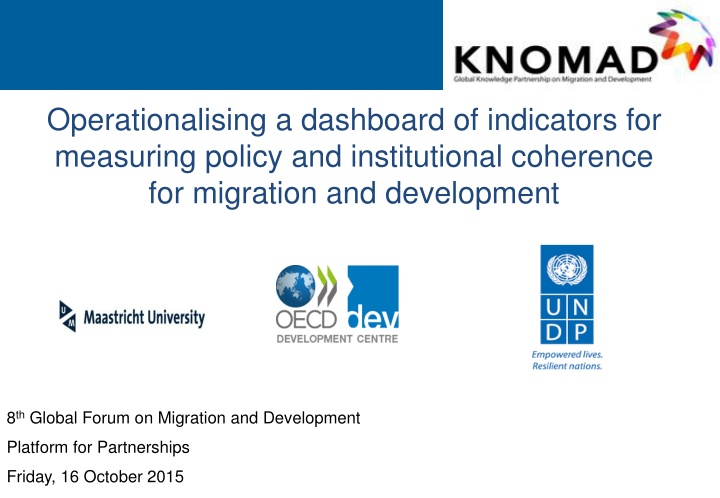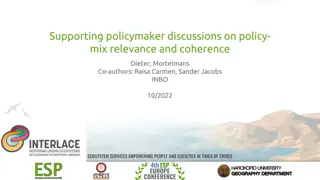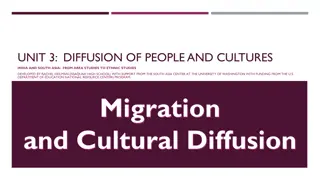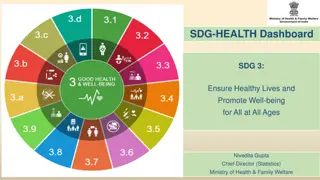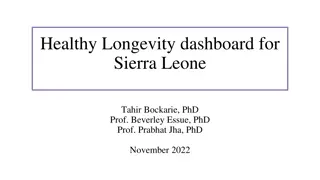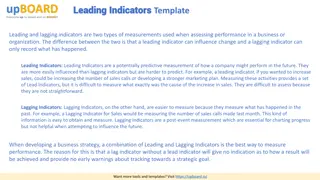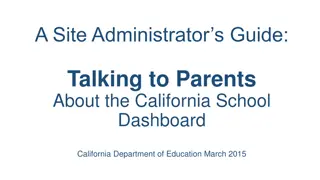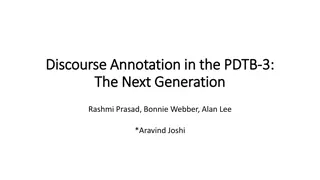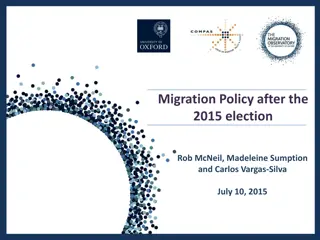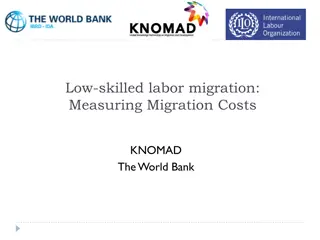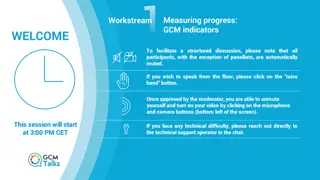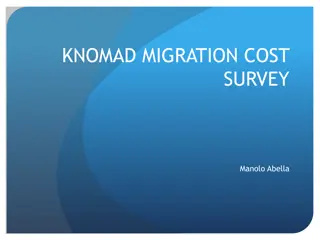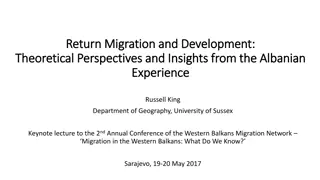Dashboard of Indicators for Policy and Institutional Coherence in Migration
The dashboard of indicators presented in the images aims to encourage critical self-assessment of policy coherence, identify areas for improvement, and promote understanding of migration and development links. It operationalizes key objectives through example indicators and pilot countries, focusing on promoting institutional coherence, reducing migration costs, protecting migrant rights, promoting integration, and enhancing development impact.
Download Presentation

Please find below an Image/Link to download the presentation.
The content on the website is provided AS IS for your information and personal use only. It may not be sold, licensed, or shared on other websites without obtaining consent from the author.If you encounter any issues during the download, it is possible that the publisher has removed the file from their server.
You are allowed to download the files provided on this website for personal or commercial use, subject to the condition that they are used lawfully. All files are the property of their respective owners.
The content on the website is provided AS IS for your information and personal use only. It may not be sold, licensed, or shared on other websites without obtaining consent from the author.
E N D
Presentation Transcript
Operationalising a dashboard of indicators for measuring policy and institutional coherence for migration and development 8thGlobal Forum on Migration and Development Platform for Partnerships Friday, 16 October 2015
The dashboard of indicators Objectives Encourage policy makers to reflect on their own context Enable critical self-assessment of policy coherence Identify areas for improvement Promote understanding of the links between migration and development in different contexts
Dashboard operationalisation 10 pilot countries
How does the dashboard work? 5 policy dimensions 1 Promote institutional coherence Reduce the costs of migration 2 Protect the rights of migrants and their families 3 Promote the (re)integration of migrants 4 Enhance the development impact of migration 5
Example indicators Nationally representative data on international migration is systematically collected through the country s census, labour force survey (LFS) or other national surveys and is publicly available. 0 = no 5 = nationally representative data on migration are collected in country s LFS, census and/or other national survey(s) 10 = nationally representative data on migration are collected in the country s LFS, census and/or other national survey(s) and are publicly available. DIMENSION 1 Promote institutional coherence for migration and development origin/ destination There is an inter-agency mechanism, e.g., a body or committee, that allows for the consideration of migration (and development) in other policy sectors. 0 = no mechanism, or those participating in mechanism have not met in last year 5 = mechanism exists and those participating in it have met once in last year 10 = mechanism exists and those participating in it have met more than once in last year
Example indicators There are no recruitment costs for migrants. 0 = recruitment fees exceed what is chargeable by law, or there is no law in place 5 = recruitment fees chargeable are limited by law 10 = there are no recruitment costs for migrants origin/ destination Recruitment fees for migrant workers are regulated by law. 0 = recruitment fees exceed what is chargeable by law, or there is no law in place 5 = recruitment fees chargeable are limited by law 10 = there are no recruitment costs for migrants DIMENSION 2 origin/ destination Reduce the costs of migrating Passport costs are less than X% of annual per capita income. 0 = no 5 = no, between X% and Y% 10 = yes, less than X% origin
Example indicators Consular services in main destination countries include a special mechanism for protecting migrants rights (such as a labour attach , social attach or direct hotline). 0 = no, 10 = yes origin DIMENSION 3 Protect the rights of migrants and their families Migrants and their family members, regardless of status, have the same right to primary, secondary and tertiary education as citizens. 0 = no access 5 = access to primary and secondary education 10 = access to primary, secondary and tertiary education destination
Example indicators Country has mechanisms (such as mutual recognition agreements) that promote (i) the recognition of degrees and skills from the origin country in destination countries and (ii) the recognition of degrees and skills gained abroad. 0 = no, 10 = yes DIMENSION 4 origin Promote the integration and re-integration of migrants There is a system for the recognition of foreign degrees and skills from countries of origin. 0 = no, 10 = yes destination
Example indicators By 2030, the transaction costs of migrant remittances are reduced to less than 3 per cent and remittance corridors with costs higher than 5 per cent are eliminated. 0 = the average transaction cost for migrant remittances is 3 per cent or more 5 = the average transaction cost for migrant remittances is less than 3 per cent 10 = the average transaction cost for migrant remittances is less than 3 per cent and no corridor exceeds 5 per cent origin/ destination DIMENSION 5 Enhance the development impact of migration There are no restrictions or taxes on the inflow/outflow of remittances. 0 = there are taxes on the inflow/outflow of remittances 5 = there are restrictions other than taxes (such as capital controls) on the inflow/outflow of remittances 10 = there are no restrictions or taxes on the inflow/outflow of remittances origin/ destination Migrants pathway to citizenship or permanent residency is unaffected by temporary stays (of three months or less) out of the country. 0 = no 10 = yes destination
Presenting results Two dashboards countries of origin countries of destination Two methods for presenting results Radar charts Traffic lights
Presenting results Option 1: Radar charts Institutional coherence Countries of origin 100 90 80 70 Institutional coherence 60 50 Development impact Migration costs 40 100 30 90 20 10 80 0 70 60 50 Development impact Migration costs 40 30 20 10 Migrants' integration Migrants' rights 0 Countries of destination Migrants Migrants' reintegration (re)integration Migrants' rights
Presenting results Option 2: Traffic lights Countries of origin 0 - 49 50 - 79 80 - 100 Institutional coherence Reducing costs (Re)integration Development impact Migrants rights Country A Country B Country C Country D Country E
Moving forward Next steps Expand operationalisation of dashboard to 20-25 countries Oct 2015- Feb 2016 Technical workshop on scoring/weighting Workshop on synergies between dashboard and SDGs National workshops Jan 2016 Jun 2016 Publication of report on dashboard operationalisation Nov/Dec 2016
Thank you 8thGlobal Forum on Migration and Development Platform for Partnerships Friday, 16 October 2015
